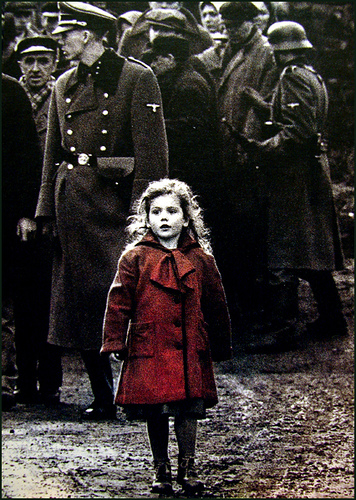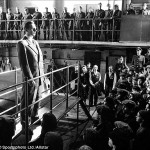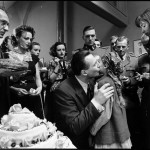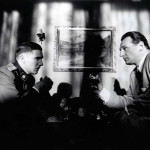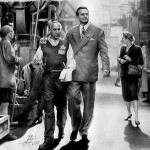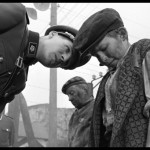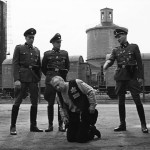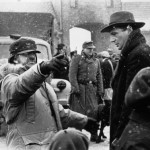Having just published a blog on Movies That Make Me Cry, I suddenly realised I have never reviewed Schindler’s List. An omission to be corrected without delay! Here’s what I said in the potted summary:
Granted that the ending of survivors placing stones on Schindler’s grave is a tad OTT, but is there anybody who doesn’t weep at the pathos of the story of a Nazi sympathiser and failed businessman who rescued hundreds of Jews from slaughter? Unquestionably Spielberg’s finest hour.
In fact there are two passages in the film where Spielberg reverts to type and overplays the syrupy schmaltz factor, the ending and also the only colour within an otherwise black and white movie, following the movements of the girl in a red coat. While unquestionably moving, the use of this gimmick overplays the pathos. This is a film where subtlety and sensitivity are repaid a hundred fold; gilding the lily crushes the delicate flower.
However, if those are my only two gripes, it says a lot for the remainder of the movie, which, like many classics, is much the richer in texture and contrast for being made in black and white.
In my 20s I read Thomas Keneally‘s book Schindler’s Ark, but for these purposes I will assume you don’t know the plot, which is of course based on the true story of Oskar Schindler. Courtesy of Wikipedia:
In 1939, the Germans move Polish Jews to the Kraków Ghetto as World War II begins. Oskar Schindler, an ethnic German businessman from Moravia, arrives in the city hoping to make a fortune as a war profiteer. Schindler, a member of the Nazi Party, lavishes bribes upon Wehrmacht and SS officials. Sponsored by the military, Schindler acquires a factory for the production of army mess kits. Not knowing much about how to run such an enterprise, he gains a collaborator, Itzhak Stern, an official of Krakow’s Judenrat (Jewish Council) who has contacts with the Jewish business community and the black marketers inside the ghetto. The Jewish businessmen lend Schindler money in return for a share of products produced. Opening the factory, Schindler pleases the Nazis and enjoys newfound wealth and status as “Herr Direktor”, while Stern handles administration. Schindler hires Jewish Poles instead of Catholic Poles because they cost less. Workers in Schindler’s factory are allowed outside the ghetto, and Stern ensures that as many people as possible are deemed “essential” to the German war effort, saving them from being transported to concentration camps or killed.
SS-Lieutenant (Untersturmführer) Amon Goeth arrives in Kraków to oversee construction of the Płaszów concentration camp. Once the camp is completed, he orders the liquidation of the ghetto and Operation Reinhard in Kraków begins, with hundreds of troops emptying the cramped rooms and arbitrarily murdering anyone who is uncooperative, elderly or infirm. Schindler watches the massacre and is profoundly affected. He nevertheless is careful to befriend Goeth and, through Stern’s attention to bribery, Schindler continues enjoying SS support. Schindler bribes Goeth into allowing him to build a sub-camp for his workers, so that he can keep his factory running smoothly and protect them. As time passes, Schindler tries to save as many lives as he can. As the war shifts, Goeth is ordered to ship the remaining Jews to the Auschwitz concentration camp.
Schindler prepares to leave Kraków with his fortune. He finds himself unable to do so, however, and prevails upon Goeth to allow him to keep his workers so he can move them to a factory in his old home of Zwittau-Brinnlitz, away from the Final Solution. Goeth charges a massive bribe for each worker. Schindler and Stern assemble a list of workers to be kept off the trains to Auschwitz.
“Schindler’s List” comprises these “skilled” inmates, and for many of those in Płaszów, being included means the difference between life and death. Almost all of the people on Schindler’s list arrive safely at the new site. The train carrying the women is accidentally redirected to Auschwitz. Schindler bribes the camp commander, Rudolf Höß, with a cache of diamonds in exchange for releasing the women to Brinnlitz. Once the women arrive, Schindler institutes firm controls on the SS guards assigned to the factory, forbidding them to enter the production areas. He encourages the Jews to observe the Sabbath. To keep his workers alive, he spends much of his fortune bribing Nazi officials and buying shells from other companies; he never produces working shells during the seven months his factory operates. He runs out of money just as the Wehrmacht surrenders, ending the war in Europe.
May 8, 1945: The workers and Germans listen to British Prime Minister Winston Churchill‘s speech of the Unconditional Surrender of Germany to the Allies. As a Nazi Party member and a self-described “profiteer of slave labor”, in 1945, Schindler must flee the advancing Red Army. Although the SS guards have been ordered to kill the Jews, Schindler persuades them to return to their families as men, not murderers. In the aftermath, he packs a car in the night and bids farewell to his workers. They give him a letter explaining he is not a criminal to them, together with a ring secretly made from a worker’s gold dental bridge and engraved with a Talmudic quotation, “Whoever saves one life saves the world entire”. Schindler is touched but deeply ashamed as he leaves, feeling he could have done more to save lives, such as selling his car and Golden Party Badge.
The Schindler Jews are awakened by sunlight the next morning. A Soviet dragoon announces that they have been liberated by the Red Army. The Jews walk to a nearby town in search of food.
After a few scenes depicting post-war events such as the execution of Amon Goeth and a summary of what happened to Schindler in his later years, the Jews are shown walking to the nearby town. The black-and-white frame changes to one in color of present-day Schindler Jews at Schindler’s grave site in Jerusalem, where he wanted to be interred. A procession of now-elderly Jews who worked in Schindler’s factory set stones on his grave—a traditional Jewish custom denoting gratitude to the deceased. The actors portraying the major characters walk with them. Ben Kingsley is accompanied by the widow of Itzhak Stern, who died in 1969. A title card reveals that at the time of the film’s release, there were fewer than 4,000 Jews left alive in Poland, but more than 6,000 descendants of the Schindler Jews throughout the world. In the final scene, Liam Neeson places a pair of roses on the grave and stands over it.
While there are many characters portrayed in this movie, many of them based on real people, the narrative drive is provided by two relationships: between Liam Neeson‘s Oskar Schindler and Ben Kingsley‘s Itzhak Stern; and between Schindler and Ralph Fiennes‘ Amon Goeth, three very different characters: the womanising chancer out for a quick buck, the worthy and humble Jewish accountant, and the psychotic camp commandant (the sort of man who chooses to shoot the Jewish architect who warns that the building under construction will collapse, before taking her advice.)
Schindler’s businesses failed throughout his life, so he lived his life by being an opportunist, a true pragmatist. Membership of the Nazi party in the 30s seemed the obvious move when he saw which way the wind was blowing. The war marked his major opportunity to make money, enjoy a luxurious lifestyle in an apartment sequestered from a wealthy Jewish family, and employing Jews with skills for nothing was the best way to achieve it.
Identifying in Stern a man who could run his business, the skill Schindler never had, and persuading Nazi leaders including Goeth, to whom Jews were lower than vermin, to allow him to employ Stern and a quota of Jews from the Krakow ghetto and concentration camp was his master stroke.
That these relationships are so credible is testament to the quality of performances from Neeson, Kingsley and Fiennes, particularly the credibility of Fiennes, whose minor streak of humanity lasts only long enough to kill its recipient with a rifle minutes later – a fascinating contrast to the humanity of Schindler, who seems outwardly almost ashamed of his actions.
It might have ended there but for one Schindler’s change of tune. Somewhere within the man was a spark of humanity and heroism that caused him not only to sacrifice his own potential fame and fortune but also to risk his own life by taking a thousand Jews to a safe neutral territory and away from the threat of extermination, employing them in his factory to make armaments that would never kill. We could debate whether the movie gets close to understanding the psychology that caused Schindler to forget his own rhetoric about being a businessman who cared solely about profit, though Spielberg treads lightly on this point.
However, the director takes very seriously the accurate depiction of the ghetto, of conditions in the concentration camp, of the known behaviour of the real life characters and the history behind them. This is one of the more accurate depictions of history by Hollywood, perhaps surprisingly so given the track record of Hollywood for playing fast and loose with historical truths, but given that Schindler’s story touched a personal nerve within Spielberg maybe not so surprising at all. Whether the Nazis were so one-dimensionally, unremittingly cruel in reality is not clear, but they come out of the book no better than the movie.
Within the weaving of fact and fiction, there is a sure touch to this movie, moving and all the more effective for not being overplayed (two instances mentioned above notwithstanding.) Criticisms apart, this is a finely constructed movie and a tribute not only to Schindler but all those taking part. If you have not already seen it, get the DVD without delay. This is unmistakably a modern classic.

